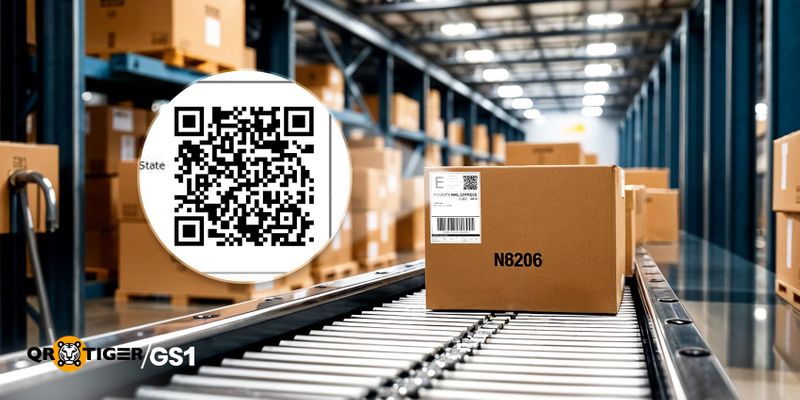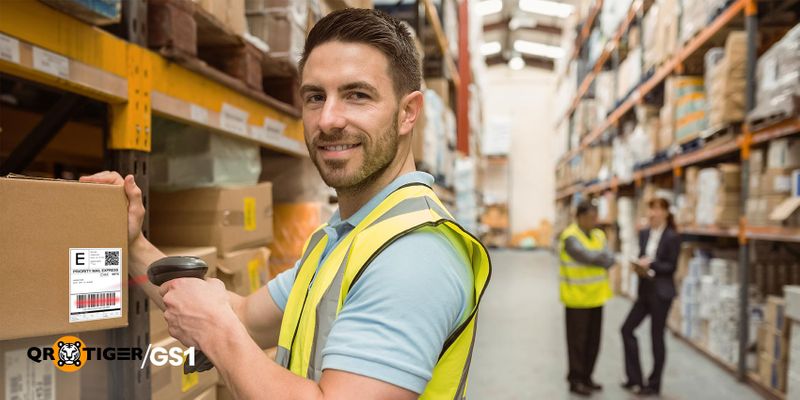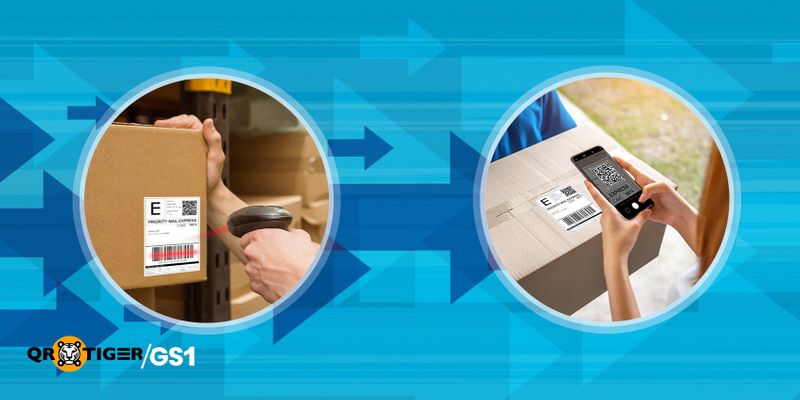S4T: Using a GS1 QR Code for Supply Chain Distribution

Distribution systems today are under increasing pressure. Deliveries are expected to be faster, more accurate, and fully traceable at every stage. To support this demand, logistics teams need better access to delivery-related information, right when it’s needed.
While still widely used, the traditional linear barcode can no longer meet these expectations. It carries only a single piece of information, usually a product identifier, and does not support real-time updates or additional supply chain data.
This is where 2D barcodes offer a practical upgrade. The technology itself isn’t new, but how it’s being applied today is.
Using a GS1 QR code for supply chain distribution, through what is known as the Scan4Transport standard, builds on the same scanning processes already used in warehouses and logistics. The difference is that this format allows more data to travel with each product
What is Scan4Transport (S4T)?
Scan4Transport, or S4T for short, is a global standard created by GS1. Its purpose is simple but highly practical: to encode transport and logistics data into a 2D barcode, such as a GS1 Digital Link QR Code or DataMatrix, and apply that barcode directly to freight. This includes cartons, pallets, and individual parcels.
The idea was championed by GS1’s Global Working Group, led by Michiel Ruighaver of GS1 Australia. They started the project in early 2019, and by August 2020, the standard was officially ratified.
This wasn’t done in isolation. The group included operators like AusPost, DHL, Correios Brazil, VT Freight Express, along with shippers, solution providers, and GS1 organizations from over 22 countries
Instead of relying on printed labels that require manual reading or interpretation, S4T shifts important delivery data into a format that machines can read instantly. That includes addresses, routing instructions, delivery conditions, and more.
It’s built for real-world logistics, from the first mile through warehouse sortation to the final doorstep. This standard enables faster scans, fewer errors, and improved handoffs between logistics systems, even when those systems don’t speak the same language.
At its core, S4T replaces static, human-readable text with structured, machine-readable data. This gives carriers and shippers the ability to access delivery-critical information instantly.
How Scan4Transport works
Goods travel through several stages before they reach their destination:
- First Mile — from the manufacturer or seller to a warehouse or distribution center.
- Middle Mile — bulk transport between facilities, such as from a central warehouse to a regional hub.
- Last Mile — the final leg from a local hub to the recipient’s address.
- Reverse Logistics — handling returns, damaged goods, or items sent back for recycling.
With Scan4Transport, a 2D barcode carries all the key delivery details: full addresses, delivery time windows, handling instructions, and safety flags, all formatted using GS1 Application Identifiers (AI). These are standardized tags that tell scanners exactly what each piece of data means.
At each stage, the label is scanned:
- At the loading dock during the first mile
- In sorting hubs during the middle mile
- At the point of handoff in the last mile
- Even during returns in reverse logistics
Each scan instantly displays the structured data on the label itself, ensuring visibility even if the backend system is slow or unavailable.

Core Components of S4T label
Scan4Transport’s efficiency stems from its structured approach to data encoding and label design. Three core components enable smooth integration across supply chains while preserving compatibility with legacy systems.
GS1 Digital link 2D barcode with structured data
At the center of S4T are GS1 2D barcodes that can store multiple logistics data points in a single scan. These barcodes are structured using GS1 Application Identifiers, which clearly define the purpose of each data field. For example, AI (410) represents the ship-to location, while (422) indicates the country of origin.
This structure allows systems to instantly interpret the data without querying external databases, which is critical for environments where speed or offline functionality is required.
In addition, GS1 Digital Link QR Codes can include embedded URLs, connecting shipments directly to digital assets such as live tracking pages or electronic documentation. This makes the label not just scannable—but smart and connected.
GS1-128 for redundancy
To support legacy operations, the label must include the GS1-128 linear barcode on the same label. This barcode carries the SSCC (Serial Shipping Container Code), a globally unique identifier for each logistics unit.
Although it lacks the data depth of a 2D barcode, the GS1-128 serves as a reliable fallback for systems that still rely on traditional scanning infrastructure. Its inclusion ensures that shipments can still be tracked and processed, even in non-2D-capable environments.
Logistics label structure and human-readable information (HRI)
Label design follows a clear hierarchy: the 2D barcode is primary, followed by the optional GS1-128, and finally, the Human-Readable Interpretation (HRI) beneath each code.
In plain text, the HRI displays critical details, like shipment IDs, destination addresses, and handling instructions. This allows for manual verification in case of barcode damage or scanner failure.
Standardized layout also plays a key role in international logistics. It reduces confusion across regions, languages, and differing operational practices, especially at handoff points like customs or third-party hubs.
Benefits of integrating GS1 QR codes for logistics
While traditional barcodes struggle with modern logistics demands, Scan4Transport (S4T) delivers tangible operational advantages:
Cross-carrier interoperability
S4T's GS1 standardization enables seamless handoffs between competing logistics providers. A pallet labeled in a DHL facility can be instantly processed by FedEx or AusPost without relabeling - critical for multi-partner supply chains.Automated compliance handling
The system can automatically encode:- Hazard classifications (UN codes) for dangerous goods
- Temperature bands for perishable shipments
- Legal traceability data for regulated industries
This eliminates manual paperwork checks at inspection points.
Supports just-in-time delivery
In just-in-time operations, precise timing is critical. S4T-enabled barcodes ensure that every incoming shipment can be verified and recorded the moment it’s unloaded. If there’s a shortfall or mismatch, it’s detected immediately, avoiding delays further down the chain.
Enhance shipment and inventory visibility
Because GS1 Digital Link 2D barcodes can be scanned at multiple points, from receiving to dispatch and even during transport, they create a unified record of item movement. This visibility supports quick stock transfers between facilities if one location runs low, helping maintain service levels without overstocking.
Offline resilience built in
One of the main drawbacks of traditional 1D barcodes, such as the GS1-128, is that they only carry the SSCC, a reference number.
To retrieve the full delivery details, a system lookup is required, usually involving access to a database or backend server.
That’s a problem in areas with poor connectivity or during system outages.
Scan4Transport solves this by embedding all critical transport data directly into the 2D barcode. This includes address information, handling instructions, time windows, and more. Because the data travels with the freight, there’s no need to look anything up. A simple scan reveals everything, even if the scanner is offline.
This offline capability makes it ideal for remote distribution centers, mobile delivery units, and any logistics process where reliability can’t depend on network access.
Future-proof data capacity
2D barcodes, especially those based on the GS1 Digital Link standard, can point to external data sources, giving them far more flexibility than traditional formats.
These barcodes can link to:
- Sensor data such as temperature, shock, or humidity logs
- Blockchain hash references to verify authenticity and chain of custody
- Multilingual delivery instructions based on receiver location or preferences
- Updated delivery information, like revised drop-off times or change-of-address requests made by the recipient
This dynamic links printed labels with real-time logistics platforms, allowing stakeholders to access the most current instructions or context.
The only limitation?
If there is no network connection at the scan point, the system will default to the data embedded in the barcode. This means the delivery will proceed based on what's printed and encoded on the label, even if newer instructions exist online.
That’s why GS1 2D barcodes balance dynamic linking with offline resilience: critical data can still be acted on, even when systems aren’t connected.

Considerations before Scan4Transport adoption
Before adding Scan4Transport into your logistics workflow, it’s worth weighing a few practical points:
Cost of adoption: Expect expenses for printers that can produce high-quality 2D barcodes, scanners that can read them, and any necessary software updates. Your systems must also recognize GS1 Application Identifiers, which could mean reconfiguring or upgrading existing tools.
Not all partners use GS1 standards: Some distribution centers operate on proprietary or non-GS1 formats. In these cases, Scan4Transport might only work internally or require extra steps for compatibility.
Backend systems still matter: The label provides a fast, reliable reference but shouldn’t replace live system checks. Real-time updates such as route changes or last-minute delivery instructions,
will usually only be found in your backend platform.
Training and process alignment: Staff across all delivery stages need to know when and why to scan. Without consistent use, the label’s benefits are reduced.
Thinking through these points early will help ensure that Scan4Transport is a complement to your existing systems rather than an underused extra step.
Advancing supply chain distribution without replacing the core process
Using a GS1 QR code for supply chain distribution based on Scan4Trasport standards addresses today’s demand for faster, more accurate, and more connected logistics.
It works within the familiar flow of distribution, from first mile to last, without forcing a complete overhaul of established processes.
Instead, it builds on what already works, adding structured, machine-readable data that strengthens visibility, improves accuracy, and enables smoother collaboration between partners.
The result is a supply chain that keeps pace with modern expectations while staying grounded in proven operational methods.
Frequently asked questions
When was Scan4Transport introduced?
Scan4Transport was developed by a GS1 global group in 2019, officially ratified in August 2020, and piloted worldwide in 2021 to improve logistics data sharing.
Is using S4T mandatory
No, using Scan4Transport is not mandatory. Companies adopt an optional GS1 standard to improve transport label data sharing and efficiency.
Why should I incorporate GS1 2d barcodes in my logistics labels?
Incorporating 2D barcodes in logistics labels lets you store more shipment details, improve tracking, reduce errors, and support faster, more accurate deliveries.
Do GS1 QR codes require internet connectivity to get the information or be tracked?
No. GS1 QR codes store shipment details directly in the code, so scanners can read them offline. In most delivery tracking systems, scans are saved locally and synced to the backend when network access returns.
DISCLAIMER: We acknowledge that GS1, as well as the materials, proprietary items, and all related patents, copyright, trademark, and other intellectual property (collectively, “intellectual property”) relating to its use, are the property of GS1 Global, and that our use of the same shall be in accordance with the conditions provided by GS1 Global.




